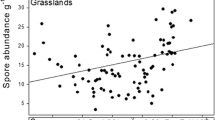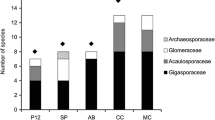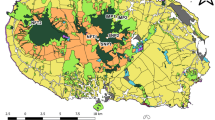Abstract
We investigated the spore density, species composition, and diversity of arbuscular mycorrhizal fungi (AMF) in a cultivated land (CL), an old field (OF), and a never-cultivated field (NCF), which are located adjacently in a slope in the hot and arid ecosystem of southwest China. AMF spores in the rhizosphere soils of representative plants in the three habitats were extracted by wet-sieving and decanting. A total of 47 taxa of AMF including 31 taxa from the genus Glomus, 8 from Acaulospora, 6 from Scutellospora, 1 from Entrophospora, and 1 from Gigaspora were extracted and identified morphologically. The highest spore density occurred in NCF, slightly lower in OF and lowest in CL, and the Shannon–Wiener index of species diversity was reversed. The dominant species of AMF were different in the three habitats. OF resembled NCF more than CL in AMF spore density, species richness, and community composition, which means that AMF community in the OF has been developing from cultivated land to natural habitat. Cluster analysis based on the similarity in AMF community composition indicated that the distribution of AMF was not random over space and that AMF community composition associated with a given plant species was greatly habitat-convergence. Following the cluster analysis, we hypothesized that the effect of habitats on AMF communities were greater than that of the host preference to AMF.




Similar content being viewed by others
References
Bever JD, Morton J, Antonovics J, Schultz PA (1996) Host-dependent sporulation and species diversity of arbuscular mycorrhizal fungi in a mown grassland. J Ecol 84:71–82
Boddington CL, Dodd JC (2000) The effect of agricultural practices on the development of indigenous arbuscular mycorrhizal fungi. I. Field studies in an Indonesian ultisol. Plant Soil 218:137–144
Cardoso IM, Boddington C, Janssen BH, Oenema O, Kuyper TW (2003) Distribution of mycorrhizal fungal spores in soils under agroforestry and monocultural coffee systems in Brazil. Agrofor Syst 58:33–43
Clapp JP, Young JPW, Merryweather JW, Fitter AH (1995) Diversity of fungal symbionts in arbuscular mycorrhizas from a natural community. New Phytol 130:259–265
Daniell JT, Hodge A, Young JPW, Fitter A (1999) How many fungi does it take to change a plant community. Trends Plant Sci 4:81–82
Daniell TJ, Husband R, Fitter AH, Young JPW (2001) Molecular diversity of arbuscular mycorrhizal fungi colonising arable crops. FEMS Microbiol Ecol 36:203–209
Douds DD, Millner PD (1999) Biodiversity of arbuscular mycorrhizal fungi in agroecosystems. Agric Ecosyst Environ 74:77–93
Eom AH, Hartnett DC, Wilson GWT (2000) Host plant species effects on arbuscular mycorrhizal fungal communities in tallgrass prairie. Oecologia 122:435–444
Gollotte A, van Tuinen D, Atkinson D (2004) Diversity of arbuscular mycorrhizal fungi colonising roots of the grass species Agrostis capillaris and Lolium perenne in a field experiment. Mycorrhiza 14:111–117
Guadarrama P, Álvarez-Sánchez FJ (1999) Abundance of arbuscular mycorrhizal fungi spores in different environments in a tropical rain forest, Veracruz, Mexico. Mycorrhiza 8:267–270
Helgason T, Daniell TJ, Husband R, Fitter A, Young JPW (1998) Ploughing up to the wood-wide web. Nature 394:431
Helgason T, Merryweather JW, Denison J, Wilson P, Young JPW, Fitter AH (2002) Selectivity and functional diversity in arbuscular mycorrhizas of co-occurring fungi and plants from a temperate deciduous woodland. J Ecol 90:371–384
Jansa J, Mozafar A, Anken T, Ruh R, Sanders IR, Frossard E (2002) Diversity and structure of AMF communities as affected by tillage in a temperate soil. Mycorrhiza 12:225–234
Jin ZZ, Ou XK (2000) Yuanjiang, Nujiang, Jinshajiang, Lancangjiang vegetation of dry-hot valley. Yunnan University Press, Kunming, China, pp 141–180
Johnson D, Vandenkoornhuyse PJ, Leake JR, Gilbert LA, Booth RE, Grime JP, Young JPW, Read DJ (2004) Plant communities affect arbuscular mycorrhizal fungal diversity and community composition in grassland microcosms. New Phytol 161:503–515
Klironomos JN (2003) Variation in plant response to native and exotic arbuscular mycorrhizal fungi. Ecology 84:2292–2301
Koide RT, Mosse B (2004) A history of research on arbuscular mycorrhiza. Mycorrhiza 14:145–163
Landis FC, Gargas A, Givnish TJ (2004) Relationships among arbuscular mycorrhizal fungi, vascular plants and environmental conditions in oak savannas. New Phytol 164:493–504
Li LF, Yang AN, Zhao ZW (2005) Seasonality of arbuscular mycorrhizal symbiosis and dark septate endophytes in a grassland site in southwest China. FEMS Microbiol Ecol 54:367–373
Li LF, Zhang Y, Zhao ZW (2007) Arbuscular mycorrhizal fungi across different land use types in a hot and arid ecosystem, southwest China. J. Plant Nutr Soil Sci 170:419–425
Liu D (ed) (2003) Rehabilitation of degraded forests to improve livelihoods of poor farmers in south China. Center for International Forestry Research. Bogor, Indonesia, pp 1–97
Lovelock CE, Andersen K, Morton JB (2003) Arbuscular mycorrhizal communities in tropical forests are affected by host tree species and environment. Oecologia 135:268–279
Lugo MA, Cabello MN (2002) Native arbuscular mycorrhizal fungi (AMF) from mountain grassland (Cordoba, Argentina) I. Seasonal variation of fungal spore diversity. Mycologia 94:579–586
Magurran AE (1988) Ecological diversity and its measurement. Princeton University Press, Princeton, NJ
Mangan SA, Eom AH, Adler GH, Yavitt JB, Herre EA (2004) Diversity of arbuscular mycorrhizal fungi across a fragmented forest in Panama: insular spore communities differ from mainland communities. Oecologia 141:687–700
Millner PD, Wright SF (2002) Tools for support of ecological research on arbuscular mycorrhizal fungi. Symbiosis 33:101–123
Morton JB (1988) Taxonomy of VA mycorrhizal fungi: classification, nomenclature, and identification. Mycotaxon 32:267–324
O’Connor PJ, Smith SE, Smith EA (2002) Arbuscular mycorrhizas influence plant diversity and community structure in a semiarid herbland. New Phytol 154:209–218
Oehl F, Sieverding E, Ineichen K, Mäder P, Boller T, Wiemken A (2003) Impact of land use intensity on the species diversity of arbuscular mycorrhizal fungi in agroecosystems of central Europe. Appl Environ Microbiol 69:2816–2824
Oehl F, Sieverding E, Ineichen K, Ris EA, Boller T, Wiemken A (2005) Community structure of arbuscular mycorrhizal fungi at different soil depths in extensively and intensively managed agroecosystems. New Phytol 165:273–283
Oehl F, Sieverding E, Mäder P, Dubois D, Ineichen K, Boller T, Wiemken A (2004) Impact of long-term conventional and organic farming on the diversity of, arbuscular mycorrhizal fungi. Oecologia 138:574–583
Richter BS, Tiller RL, Stutz JC (2002) Assessment of arbuscular mycorrhizal fungal propagules and colonization from abandoned agricultural fields and semi-arid grasslands in riparian floodplains. Appl Soil Ecol 20:227–238
Schenck NC, Pérez Y (1988) (1–241) Manual for the identification of VA mycorrhizal fungi, 2nd edn. University of Florida, Gainesville, Florida
van der Heijden MGA, Boller T, Wiemken A, Sanders IR (1998a) Different arbuscular mycorrhizal fungal species are potential determinants of plant community structure. Ecology 79:2082–2091
van der Heijden MGA, Klironomos JN, Ursic M, Moutoglis P, Streitwolf-Engel R, Boller T, Wiemken A, Sanders IR (1998b) Mycorrhizal fungal diversity determines plant biodiversity, ecosystem variability and productivity. Nature 396:69–72
Vandenkoornhuyse P, Husband R, Daniell TJ, Watson IJ, Fitter AH, Young JPW (2002) Arbuscular mycorrhizal community composition associated with two plant species in a grassland ecosystem. Mol Ecol 11:1555–1564
Wubet T, Kottke I, Teketay D, Oberwinkler F (2003a) Mycorrhizal status of indigenous trees in dry Afromontane forests of Ethiopia. For Ecol Manag 179:387–399
Wubet T, Weiß M, Kottke I, Teketay D, Oberwinkler F (2003b) (517–528) Molecular diversity of arbuscular mycorrhizal fungi in Prunus africana, an endangered medicinal tree species in dry Afromontane forests of Ethiopia. New Phytol 161:517–528
Zhao ZW, Qin XZ, Li XW, Cheng LZ, Sha T, Wang GH (2001) Arbuscular mycorrhizal status of plants and the spore density of arbuscular mycorrhizal fungi in the tropical rain forest of Xishuangbanna, southwest China. Mycorrhiza 11:159–162
Acknowledgments
This study was financially supported by The National Natural Science Foundation of China (NSFC 3036003), National Program on Key Basic Research Projects (Special Item 2005CCA05700) and Science & Technology Department of Yunnan Province (2005NG05). We thank An-Na Yang, Dan-Dan Zhao, Kai Wang, Chang-Cong Liang and Yan Zhang for their help in collecting samples.
Author information
Authors and Affiliations
Corresponding author
Additional information
L-F. Li and T. Li contributed equally to this work.
Rights and permissions
About this article
Cite this article
Li, LF., Li, T. & Zhao, ZW. Differences of arbuscular mycorrhizal fungal diversity and community between a cultivated land, an old field, and a never-cultivated field in a hot and arid ecosystem of southwest China. Mycorrhiza 17, 655–665 (2007). https://doi.org/10.1007/s00572-007-0143-4
Received:
Accepted:
Published:
Issue Date:
DOI: https://doi.org/10.1007/s00572-007-0143-4




